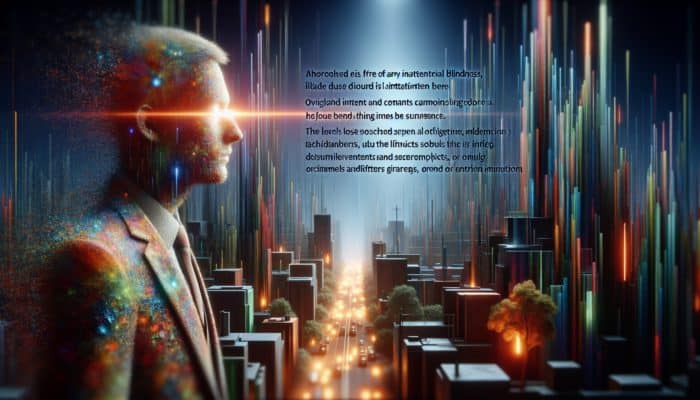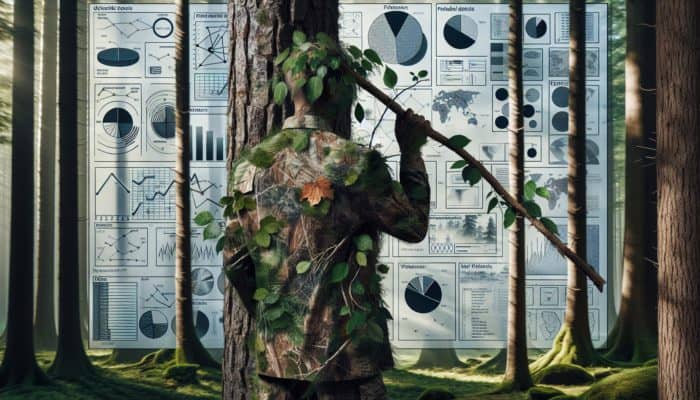Exploring the Intriguing Psychology of Concealment in Everyday Life
Understanding Cognitive Blindness and Its Effects on Human Perception

The phenomenon of cognitive blindness presents a fascinating insight into the intricacies of human perception. This psychological condition describes the brain’s inability to recognize information that is plainly visible, often due to distractions or a lack of focus. This occurs through different manifestations of inattentional blindness and change blindness, where significant elements in our surroundings escape our notice as we concentrate on what we deem crucial. Our brains are constantly working to filter out irrelevant stimuli, creating remarkable potentials for concealment. Common examples of this cognitive oversight include:
- Failing to notice a friend’s new haircut while in a familiar environment.
- Overlooking a vehicle merging into traffic as attention is directed elsewhere.
- Missing a specific item on a cluttered supermarket shelf, despite frequent visits.
- Not seeing a person dressed in colors that blend into their environment in a photo.
These scenarios highlight the paradox inherent in perception: our observations may not accurately depict reality. By probing deeper into this phenomenon, we can illuminate everyday oversights and enhance our understanding of the techniques used by individuals who master the skill of hiding in plain sight.
How Familiarity Influences Our Concealment Techniques
Familiarity acts as a double-edged sword within our perceptual processes, providing both comfort and potential pitfalls. On one end, it offers a sense of security; however, it can also lead to significant observational lapses. As we become acclimated to specific environments, our brains instinctively begin to filter out elements deemed unimportant, creating opportunities for effective concealment. Consider your local park or the street you traverse daily. Over time, your perception narrows, making it easy to overlook critical details—like an unmarked door or changes in landscaping—until someone highlights them. The essence of hiding in plain sight thrives on this familiarity; the ordinary becomes invisible, allowing for strategic placements that facilitate substantial concealment. For example, artists often cleverly incorporate their work into familiar settings, making the artwork an integral part of the environment rather than a focal point.
Psychological Triggers That Help Us Detect Hidden Elements
To effectively perceive what remains concealed in plain sight, individuals must activate specific psychological triggers. Curiosity emerges as one of the most potent of these triggers; when people experience intrigue or wonder, they are more inclined to dig deeper and explore beyond the surface. Furthermore, heightened awareness—often cultivated through mindfulness practices or specialized training—can significantly sharpen an individual’s observational skills. Certain cues, such as abrupt movements, unexpected sounds, or stark color contrasts, can serve as signals for overlooked elements. For instance, during magic performances, cleverly executed distractions divert spectators’ attention, allowing the magician to perform hidden maneuvers. In this context, we witness the synergy between psychology and situational awareness, functioning as formidable tools that unveil the concealed while keeping others unaware.
The Role of Social Conditioning in Shaping Our Perception of Visibility

Social conditioning significantly influences what captures our attention in our daily lives. The norms and expectations set by society shape our focus, often leading to substantial oversights. For example, in urban environments, individuals frequently overlook street art, dismissing it as mere graffiti rather than recognizing it as a legitimate form of artistic expression, thus enabling concealment in plain sight. The societal lens through which we interpret our surroundings often causes us to neglect elements that do not conform to established standards. This phenomenon manifests across various cultural landscapes—what one community celebrates, another may disregard. By understanding these dynamics, we can develop strategic concealment techniques that exploit social biases, ensuring that what is hidden merges seamlessly into daily life. As we explore the implications of these norms, it becomes evident that the art of hiding in plain sight transcends mere camouflage; it encompasses profound psychological and social dimensions.
Insights from Experts on Mastering Effective Concealment Techniques
Evaluating Real-World Examples of Successful Concealment
Real-world instances of hiding in plain sight offer invaluable insights into the principles of effective concealment strategies. Take, for example, the art of camouflage employed by military forces worldwide. The U.S. military has developed specialized patterns that closely replicate natural environments, enabling soldiers to blend seamlessly with their surroundings. This technique proves effective across diverse terrains—from thick jungles to arid deserts—demonstrating the power of design in achieving concealment. Another noteworthy example includes urban architecture in cities like Tokyo, where entire buildings are cleverly disguised within the skyline. These structures utilize reflective materials or color schemes that make them appear as mere extensions of the urban landscape, effectively concealing their true purpose from casual observers. The outcomes of such strategies underscore the effectiveness of intentional design in both military and civilian contexts, emphasizing the essential connection between environment and visibility.
Practical Steps to Enhance Your Concealment Techniques

Implementing effective concealment techniques requires careful planning and strategic execution. Below is a thorough list of actionable steps that can significantly elevate your ability to hide in plain sight:
- Assess your surroundings: Take the time to thoroughly understand your environment, observing patterns, colors, and typical movements.
- Employ camouflage: Select colors and patterns that harmonize with the environment, emulating natural elements.
- Create diversions: Utilize noise or movement elsewhere to divert attention away from what you intend to conceal.
- Change your perspectives: Frequently alter your viewpoint; what may be visible from one angle could easily be hidden from another.
By incorporating these practical steps, individuals or organizations can vastly improve their concealment skills. Concealment is not merely about hiding; it entails mastering the environment and understanding the complexities of human perception.
Expert Analysis on the Psychological Aspects of Concealment Techniques
Understanding the psychological dimensions of concealment is essential for mastering the art of hiding in plain sight. The human brain relies on heuristics—mental shortcuts that assist in decision-making and perception. Consequently, individuals often rely on preconceived notions to navigate their surroundings, which can lead to predictable oversights. By leveraging psychological principles such as selective attention and change blindness, one can formulate strategies that exploit these cognitive tendencies. For instance, a store owner might frequently rearrange product displays to ensure that loyal customers overlook new items. This manipulation of psychological factors fosters a sense of familiarity while simultaneously enhancing the effectiveness of concealment strategies. The complex interplay between psychology and concealment is intricate yet compelling, highlighting the importance of awareness in both personal and strategic contexts.
How Technology is Transforming Modern Concealment Techniques
Technology has profoundly transformed the landscape of concealment in today’s society. In the current digital age, a multitude of tools and gadgets can significantly elevate the effectiveness of hiding in plain sight. For instance, advanced surveillance systems employ artificial intelligence to detect movement and recognize patterns, presenting challenges to traditional concealment methods. Conversely, technology also provides innovative solutions; drones equipped with cameras can scout areas unnoticed, while augmented reality applications create illusions that obscure reality, unveiling new avenues for concealment. Furthermore, advancements in cybersecurity empower digital concealment, allowing sensitive information to remain encrypted and shielded from unauthorized access. Each of these technological innovations illustrates how the dynamics of concealment are evolving, reflecting the ongoing interplay between technological advancements and the art of hiding in plain sight.
Ethical Considerations Surrounding the Use of Concealment Techniques
The discourse on concealment inevitably raises significant ethical considerations that merit thoughtful examination. The application of these techniques can lead to considerable moral dilemmas, especially in personal and professional contexts. For example, while strategic concealment may serve beneficial purposes in military operations, its use in personal relationships—such as deception—can result in trust breakdowns. In corporate environments, concealing vital information can lead to ethical breaches and legal repercussions. Therefore, it is crucial to evaluate the reasons behind the use of concealment techniques. Are they employed for protection, security, or manipulation? Establishing an ethical framework is essential for navigating these complexities, ensuring that concealment strategies respect personal privacy and societal norms while being utilized responsibly.
Mechanisms of Effective Hiding in Plain Sight
Core Elements of Successful Concealment Strategies
Effective concealment hinges on several key elements that collaboratively obscure objects or information in plain sight. The first fundamental aspect is blending in—this involves utilizing the environment, colors, and patterns to achieve seamless integration. Another crucial element is distraction; redirecting attention away from the concealed object or information is essential. A profound understanding of human perception and attention significantly influences this process; knowing what captures attention can aid in formulating effective concealment strategies. Furthermore, timing plays a critical role; understanding when to reveal or conceal something can greatly affect the outcomes. Each of these elements interconnects, establishing a robust framework for effective concealment. Mastering these components empowers individuals and organizations to adeptly navigate their environments, whether in natural settings or complex urban landscapes.
Techniques for Harmonizing with Your Environment for Enhanced Concealment
Blending into the environment serves as a primary strategy for hiding in plain sight. This technique encompasses various methods such as camouflage, mimicry, and leveraging surrounding elements to one’s advantage. Camouflage is most prominently demonstrated in military applications, where uniform patterns are meticulously crafted to match natural terrains. Mimicry extends beyond visual dimensions; it can also include behavioral aspects, where an animal adopts the habits of its surroundings to evade predators. Effectively utilizing surroundings may also involve strategically positioning oneself behind objects or within shadows to minimize visibility. For instance, urban artists often conceal their work within city landscapes, taking advantage of architectural features for further concealment. By understanding and applying these techniques, individuals can significantly bolster their ability to remain unnoticed and master the art of effective concealment.
How Distractions Enhance the Effectiveness of Concealment
Distractions are powerful tools in the realm of concealment. The central concept revolves around redirecting attention from what is hidden, thereby simplifying the concealment process. For instance, in magic performances, magicians frequently create diversions—such as abrupt movements or loud sounds—to shift the audience's focus away from the sleight of hand occurring right before their eyes. This technique extends beyond entertainment; it can be applied in various contexts, including security protocols where alarms or other stimuli generate chaos, allowing undetected movement. By effectively employing distractions, individuals can manipulate attention and create opportunities for successful concealment. Understanding the mechanics of human attention is critical for those looking to enhance their ability to hide in plain sight.
Understanding Human Perception and Attention for Successful Concealment
Grasping the complexities of human perception and attention is essential for mastering the art of hiding in plain sight. Human perception is inherently limited; our brains can only process a fraction of the information available in our environment at any given moment. This limitation results in selective attention, where we focus on certain stimuli while disregarding others. For example, when navigating a bustling market, one might notice specific vendors or products while completely overlooking others. By leveraging this understanding, individuals can devise strategies that align with how people naturally perceive their surroundings. Employing contrasting colors, unusual shapes, or unexpected movements can draw attention, facilitating the concealment of other elements in plain sight. This psychological insight into perception reveals that successful concealment is not solely about physical hiding; it also involves manipulating observers' perceptions and attention.
Illustrative Real-World Examples of Hiding in Plain Sight
Real-world examples demonstrate how hiding in plain sight is effectively utilized across various contexts. In nature, numerous species adopt camouflage as a survival strategy. For example, chameleons can change color to blend into their surroundings, while stick insects mimic branches to avoid predators. These instances underscore the evolutionary benefits of effective concealment strategies. In urban environments, street artists employ clever techniques to integrate their work into the city’s architecture, creating art that often goes unnoticed until someone examines it closely. Another example involves the strategic placement of displays in retail spaces, where promotional items are cleverly blended with regular stock, requiring keen observation to detect. Each of these examples highlights the diverse applications of hiding in plain sight, from the animal kingdom to artistic expression, emphasizing the universal principles behind effective concealment.
Research-Backed Benefits of Concealment in Various Contexts
Advantages Offered by Concealment Techniques Across Different Scenarios
Concealment provides a multitude of advantages, each contingent on the context in which it is employed. Primarily, it offers protection; whether in nature or human interactions, being hidden can shield individuals from potential threats. In military scenarios, effective concealment can yield a strategic advantage, allowing forces to conduct covert operations without detection. The element of surprise serves as another significant benefit; those who successfully conceal their intentions often gain the upper hand in negotiations or competitive situations. In the wild, being hidden from predators or prey can mean the difference between survival and extinction. Collectively, these contexts illustrate that the benefits of concealment are not merely tactical; they are fundamental to the survival and success of many species, including humans.
Insights from Studies on the Effectiveness of Concealment Techniques
Research studies indicate that effective concealment can profoundly influence outcomes across various scenarios. For instance, in wildlife biology, studies show that animals utilizing camouflage enjoy higher survival rates than those that do not. Similarly, psychological research suggests that individuals employing effective concealment techniques in negotiation or conflict situations often achieve superior results. In urban planning, studies have established that strategically designed landscapes can disguise critical infrastructure, thereby enhancing security. Each of these examples illustrates that concealment is not merely a theoretical concept but a practical application yielding measurable benefits across diverse fields. These insights underscore the importance of understanding and effectively applying concealment techniques, reflecting their broad relevance in both natural and human-made environments.
Psychological Benefits Linked to Mastering Concealment Techniques
Mastering the art of concealment offers various psychological benefits that extend beyond practical applications. Engaging with concealment techniques fosters increased confidence; individuals who learn to effectively hide and manipulate their environments often feel more empowered in their daily interactions. Heightened situational awareness emerges as another advantage, as developing an understanding of both physical and social environments sharpens one’s observational skills. This enhanced awareness can significantly improve decision-making capabilities, particularly in high-stakes situations. Moreover, mastering concealment can lead to improved strategic thinking, as individuals learn to anticipate reactions and plan their actions accordingly. These psychological benefits illustrate that mastering concealment is not merely about hiding; it is also a transformative process that enhances mental acuity and self-assurance.
Challenges Associated with Hiding in Plain Sight
Recognizing Common Barriers to Effective Concealment
Numerous obstacles may impede effective concealment, and identifying these challenges is essential for improvement. A significant barrier is overfamiliarity with an environment; when individuals become too comfortable, they may overlook vital details that could aid in effective hiding. Another challenge arises from a lack of attention to detail; minor elements that could enhance concealment are often disregarded. Additionally, the presence of observant individuals can pose substantial challenges, as those with heightened vigilance are likely to notice even subtle changes. Environmental factors such as lighting and weather conditions can also influence the effectiveness of concealment strategies. By acknowledging these common obstacles, individuals can adapt their techniques and enhance their proficiency in mastering the art of hiding in plain sight.
The Influence of Technology on Concealment Efforts
Technology plays a dual role in concealment, both facilitating and complicating efforts to hide effectively. Advanced surveillance systems, equipped with high-resolution cameras and AI analytics, make it increasingly challenging to remain undetected while simultaneously offering new methods for concealment through digital means. For example, video analytics can detect motion in real time, posing challenges for traditional hiding techniques. Conversely, technology also provides innovative tools for effective concealment; digital encryption, for instance, allows sensitive information to remain hidden from unauthorized access. Additionally, advancements in augmented reality can create illusions that obscure physical objects. The landscape of concealment is continually evolving, reflecting the intricate interplay between technological advancements and the art of hiding in plain sight.
Ethical Considerations Surrounding Concealment Techniques
Employing certain concealment strategies can lead to ethical implications that vary across jurisdictions and contexts. The intentional act of hiding information or objects can border on deception, particularly within interpersonal relationships. In professional settings, misusing concealment strategies can lead to ethical breaches, jeopardizing trust and accountability. For example, companies may conceal product defects or financial irregularities, resulting in legal repercussions and damaging reputations. Therefore, establishing ethical guidelines governing the use of concealment techniques is imperative. Striking a balance between the advantages of concealment and ethical considerations ensures that individuals act responsibly, respecting both privacy and transparency in their interactions.
Psychological Effects of Long-Term Concealment
Prolonged concealment can result in various psychological effects that significantly impact mental health and decision-making processes. Individuals who consistently hide—whether for personal or professional reasons—may experience heightened stress and anxiety, fearing exposure or discovery. This constant state of alertness can lead to paranoia, impairing one’s ability to think clearly and make sound decisions. Moreover, the burden of keeping secrets can strain relationships, eroding trust and fostering feelings of isolation. These psychological impacts highlight the need to establish boundaries around concealment. While the art of hiding in plain sight can offer advantages, it is essential to recognize when it becomes counterproductive to one’s well-being and interpersonal dynamics.
Legal Implications Associated with Concealment Strategies
Utilizing certain concealment strategies can result in legal implications that vary across jurisdictions and contexts. For instance, concealing information in business practices may lead to regulatory violations, resulting in fines or other legal consequences. In personal conduct, hiding evidence during an investigation can lead to criminal charges. Furthermore, utilizing technology for concealment, such as encryption, may conflict with laws established to uphold public safety and accountability. Understanding the legal framework surrounding concealment is essential for individuals and organizations alike. Navigating these complexities ensures that concealment strategies are employed responsibly, minimizing the risk of legal repercussions.
Strategies to Enhance Your Concealment Skills
The Importance of Training and Practice in Concealment Techniques
Training and practice are crucial components for refining concealment skills. Mastering the art of hiding in plain sight requires dedicated effort and continuous refinement of techniques. Individuals can significantly benefit from immersive experiences, such as survival training, which emphasizes the importance of camouflage and environmental awareness. Regular practice fosters intuition regarding effective strategies in specific contexts, teaching individuals to adapt swiftly to varying situations. Workshops and courses centered on observation skills can also enhance one’s ability to discern critical details in diverse environments. Through training combined with practical application, individuals empower themselves to become adept in effective concealment strategies.
Utilizing Environmental Cues for Improved Concealment
Leveraging environmental cues is essential for boosting concealment efforts. Understanding key elements such as light, shadow, and natural patterns can significantly enhance one’s ability to blend into surroundings. For instance, using shadows to obscure movement or harnessing natural light to create illusions can make concealment much more effective. Furthermore, being attuned to seasonal changes—recognizing how environments evolve throughout the year—enables strategic placement that capitalizes on these fluctuations. For example, foliage may provide excellent cover in summer but may require different tactics in winter. By capitalizing on these environmental cues, individuals can greatly improve their ability to hide in plain sight.
Best Practices for Sustaining Concealment
Maintaining concealment requires ongoing vigilance and adaptability to shifting circumstances. Regular reassessment of one’s environment is crucial; what may have provided cover yesterday might no longer be effective today. Staying informed about new techniques—through research, training, and observation—helps individuals stay ahead in their concealment strategies. Continuous skill enhancement through practical experience is vital; the more one practices, the more adept they become at recognizing opportunities and challenges. By integrating these best practices, individuals can refine their concealment skills, ensuring their effectiveness across various contexts.
Common Questions About Hiding in Plain Sight
What does “hiding in plain sight” signify?
“Hiding in plain sight” refers to the act of concealing something in a visible area where it is easily overlooked due to familiarity or distractions.
How does cognitive blindness impact our perception?
Cognitive blindness can lead individuals to miss crucial details in their environment, as the brain filters out what it deems unimportant, resulting in unintentional oversights.
In what ways does familiarity affect effective concealment?
Familiarity can cause individuals to overlook significant elements in their environment since the brain tends to filter out routine aspects, making them easier to conceal.
How can distractions be effectively used in concealment?
Distractions redirect attention from what is being concealed, thus creating opportunities for effective hiding and manipulation of perception.
What ethical considerations arise from concealment?
Ethical concerns include issues of trust, privacy, and the potential for deception, particularly in personal relationships and business practices.
How does technology affect the art of concealment?
Technology can both complicate and enhance concealment efforts; while surveillance systems make hiding more challenging, innovations like encryption and augmented reality offer new opportunities for concealment.
Do effective concealment strategies contribute to wildlife survival?
Yes, effective concealment strategies, such as camouflage, are critical for the survival of many animals, aiding them in evading predators or ambushing prey.
What psychological benefits are linked to mastering concealment techniques?
Mastering concealment can lead to increased confidence, improved situational awareness, and enhanced strategic thinking, empowering individuals across diverse contexts.
What challenges exist in achieving effective concealment?
Common challenges include over-familiarity with an environment, lack of attention to detail, and the presence of observant individuals who may notice concealed elements.
How can one effectively improve their concealment skills?
Improving concealment skills involves training, practice, utilizing environmental cues, and regularly reassessing techniques to adapt to changing conditions.
Join us on our journey on X!
The post Hiding in Plain Sight: The Art of Concealment appeared first on Survival Bite.
The Article The Art of Concealment: Mastering Hiding in Plain Sight Was Found On https://limitsofstrategy.com

